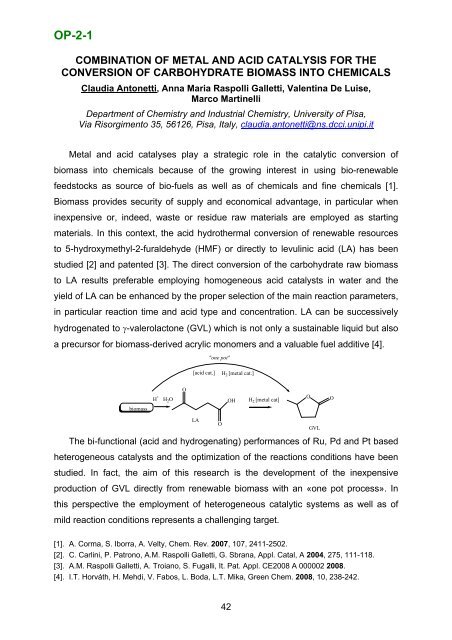Boreskov Institute of Catalysis SB RAS, Novosibirsk, Russia
Boreskov Institute of Catalysis SB RAS, Novosibirsk, Russia
Boreskov Institute of Catalysis SB RAS, Novosibirsk, Russia
- No tags were found...
You also want an ePaper? Increase the reach of your titles
YUMPU automatically turns print PDFs into web optimized ePapers that Google loves.
OP-2-1COMBINATION OF METAL AND ACID CATALYSIS FOR THECONVERSION OF CARBOHYDRATE BIOMASS INTO CHEMICALSClaudia Antonetti, Anna Maria Raspolli Galletti, Valentina De Luise,Marco MartinelliDepartment <strong>of</strong> Chemistry and Industrial Chemistry, University <strong>of</strong> Pisa,Via Risorgimento 35, 56126, Pisa, Italy, claudia.antonetti@ns.dcci.unipi.itMetal and acid catalyses play a strategic role in the catalytic conversion <strong>of</strong>biomass into chemicals because <strong>of</strong> the growing interest in using bio-renewablefeedstocks as source <strong>of</strong> bio-fuels as well as <strong>of</strong> chemicals and fine chemicals [1].Biomass provides security <strong>of</strong> supply and economical advantage, in particular wheninexpensive or, indeed, waste or residue raw materials are employed as startingmaterials. In this context, the acid hydrothermal conversion <strong>of</strong> renewable resourcesto 5-hydroxymethyl-2-furaldehyde (HMF) or directly to levulinic acid (LA) has beenstudied [2] and patented [3]. The direct conversion <strong>of</strong> the carbohydrate raw biomassto LA results preferable employing homogeneous acid catalysts in water and theyield <strong>of</strong> LA can be enhanced by the proper selection <strong>of</strong> the main reaction parameters,in particular reaction time and acid type and concentration. LA can be successivelyhydrogenated to γ-valerolactone (GVL) which is not only a sustainable liquid but alsoa precursor for biomass-derived acrylic monomers and a valuable fuel additive [4]."one pot"[acid cat.]H 2 [metal cat.]biomassH +H 2 OOOHH 2 [metal cat]OOLAOGVLThe bi-functional (acid and hydrogenating) performances <strong>of</strong> Ru, Pd and Pt basedheterogeneous catalysts and the optimization <strong>of</strong> the reactions conditions have beenstudied. In fact, the aim <strong>of</strong> this research is the development <strong>of</strong> the inexpensiveproduction <strong>of</strong> GVL directly from renewable biomass with an «one pot process». Inthis perspective the employment <strong>of</strong> heterogeneous catalytic systems as well as <strong>of</strong>mild reaction conditions represents a challenging target.[1]. A. Corma, S. Iborra, A. Velty, Chem. Rev. 2007, 107, 2411-2502.[2]. C. Carlini, P. Patrono, A.M. Raspolli Galletti, G. Sbrana, Appl. Catal, A 2004, 275, 111-118.[3]. A.M. Raspolli Galletti, A. Troiano, S. Fugalli, It. Pat. Appl. CE2008 A 000002 2008.[4]. I.T. Horváth, H. Mehdi, V. Fabos, L. Boda, L.T. Mika, Green Chem. 2008, 10, 238-242.42
















